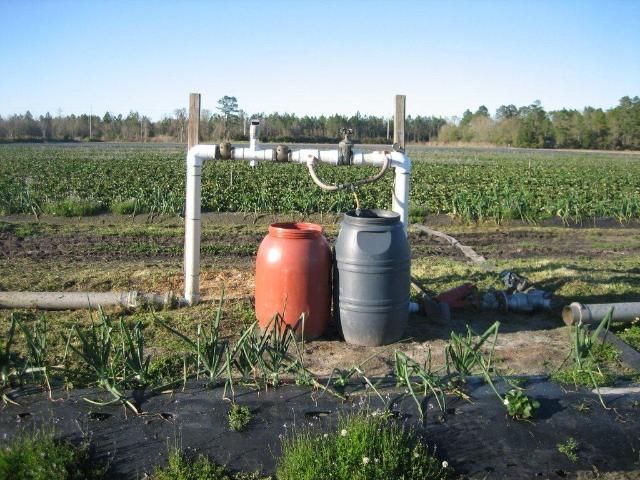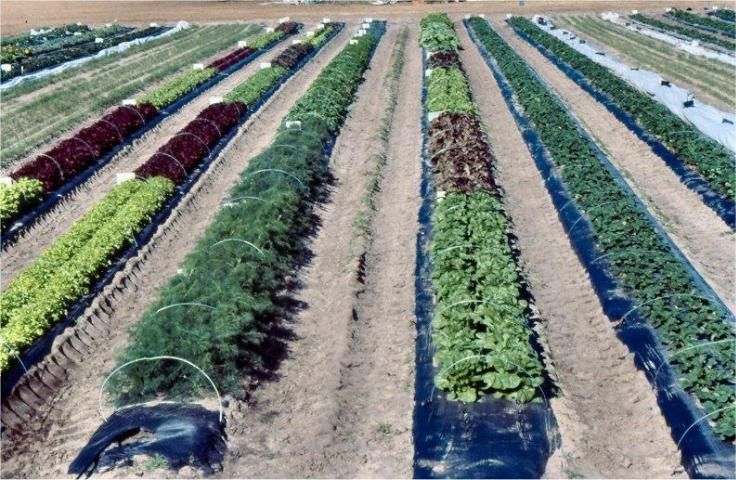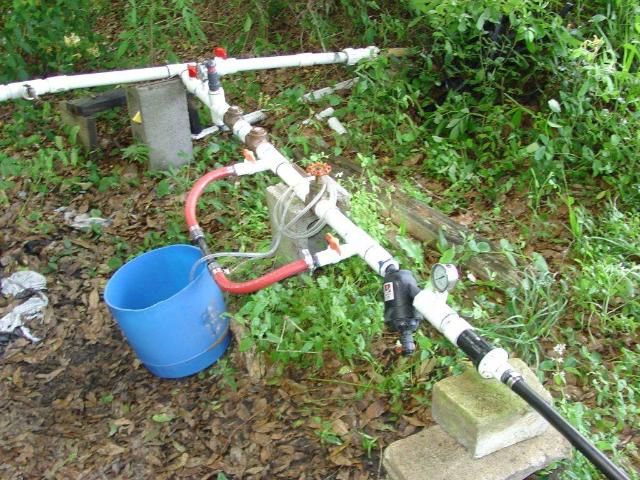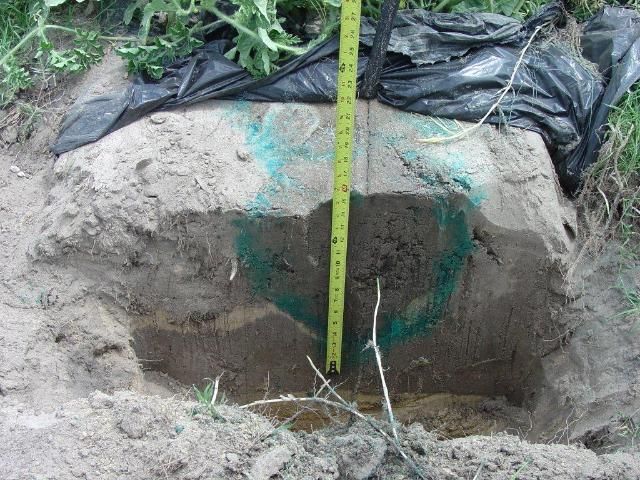Introduction
More and more farmers are growing fruits and vegetables on small acreage for specialty local markets. The production areas are often comprised of several small blocks that range from 1/10–1 acre in size and frequently utilize drip irrigation systems to deliver water and soluble fertilizers (https://edis.ifas.ufl.edu/hs388). When fertilizer is mixed and added to irrigation water, the term often used is fertigation (Figure 1). Farmers commonly grow several crops at different stages of development simultaneously in order to have a variety of produce to sell to customers at weekly intervals (Figure 2). This situation forces farmers to schedule plantings accordingly and be prepared to make several fertilizer calculations because of their diverse crop demands. Additionally, farmers can enhance their production and irrigation efficiency by grouping crops with similar nutrient requirements. Water and nutrient requirements vary according to the crop and stage of development. This guide is intended to help growers correctly interpret fertilizer recommendations and calculate accurate fertilizer amounts to be used in fertigation events based on crop nutrient requirements.

Credit: UF/IFAS

Credit: UF/IFAS
Step 1. Test the soil
Have the soil tested 1–2 months prior to planting so that liming requirements might be addressed well in advance of planting. A soil test will also assess levels of available phosphorus, potassium, magnesium, sulfur, calcium, and micronutrients (minor elements) in the soil. Typical recommendations are expressed in elemental or oxide forms needed per planted acre (https://edis.ifas.ufl.edu/ss170).
Example: 50 lbs N/acre, 30 lbs P2O5/acre, or 50 K2O/acre
Step 2. Calculate planted acre, taking into account field surface and bed spacing
The University of Florida Vegetable Production Handbook includes information about the crop nutrient requirements for specific crops and growth stages. Use the guide for specific weekly crop nutrient requirements because each crop varies. In addition, crop nutrient requirements are based on standard bed or row spacing (e.g., 8 ft for watermelon; 5 ft for tomato, pepper, cucumber, squash, and cantaloupe; and 4 ft for strawberry) (https://edis.ifas.ufl.edu/ss516).
Field surface area in acres = [Distance between the center of one bed to the center of the next bed in ft × length of beds in feet × the number of beds] divided by 43,560
Example: A strawberry field that has eight, 250 ft long beds on 4 ft centers
The resulting acreage would be:
(4 × 250 × 8) / 43,560 = 0.184 acres
Step 3. Select the correct fertilizer
Fertilizers can be formulated in three ways: granular, dry soluble, or liquid. Either dry soluble or liquid forms may be used with drip irrigation. Granular formulations are usually not used in drip irrigation systems because they are not soluble, but they are routinely used for applications to the soil before or after the beds have been formed and before or during the time when the drip tape and plastic mulch are installed. This application is referred to as the preplant application. Based on UF/IFAS recommendations, the entire crop demand for phosphorus and micronutrients should be applied in this step. Up to 50% of the total crop nutrient requirement for nitrogen (N) and potassium (K2O) may be applied in the preplant application because both elements leach readily in the soil. The remaining N and K2O should be injected in small increments during the growing season because the crop needs them in varying amounts for each particular plant growth stage. There are situations where no preplant application of N or K2O is used, meaning all N and K2O can be successfully applied via fertigation. This publication is based on programs in which all phosphorus and micronutrients, as well as a small portion of nitrogen and potassium, are applied preplant, and only nitrogen and potassium need to be supplied during the growing season. For the purposes of simplicity in this document, the general assumption is that N and K2O will be recommended in equal amounts, as is commonly the case in Florida. If fertigation plans result in injections in which N and K2O are not equal, then growers will need to use an analysis of a liquid fertilizer matching those amounts needed or use individual dry ingredients at rates that best match the recommended amounts.
Step 4. Calculate the correct amount of fertilizer needed
University of Florida researchers have determined fertilizer requirements for most vegetable crops (https://edis.ifas.ufl.edu/topic_vph). The crop nutrient requirements are usually determined on the basis of N, P2O5, or K2O pounds per acre for the entire crop cycle (https://edis.ifas.ufl.edu/pdffiles/cv/cv10100.pdf).
Example: Assume a strawberry crop soil test recommends 150 lbs N, P2O5, and K2O per acre for the entire season (https://edis.ifas.ufl.edu/pdffiles/cv/cv13400.pdf). In the case of strawberry, a typical strategy based on soil test results may be to supply 40 lbs N, 150 lbs P2O5, and 40 lbs K2O per acre in the preplant fertilizer step. The remaining 110 lbs of N and K2O will be injected weekly at 0.3–0.75 lbs/A/day, depending on the plant growth stage. The nutrients are spoon-fed to the crop in small increments because they may be leached from the soil during heavy rain events. If they were applied in their entirety early in the crop cycle, they would most likely be lost to heavy rains and need to be replaced at considerable and unnecessary expense.
Example: Using the strawberry example above, injection rates start at 0.3 lbs and increase to 0.75 lbs N and K2O per acre per day. To determine the amount needed if you inject once a week, multiply those daily amounts by 7 to convert them to lbs per acre per week (Tables 1–3) (0.75 lbs per day × 7 days = 5.25 lbs per week). Recommendations are for daily injections. However, growers may elect to inject daily, weekly, or twice weekly.
Step 5. Determine how much fertilizer is needed per planted acre
Unfortunately, all fertilizers are not created equal! This is because they are raw elements, and the presence and/or proportion of either N or K are fixed according to the type of fertilizer (Tables 1–3). This guide focuses on a few of the most common fertilizer formulations (Tables 4–7) used in drip irrigation systems on small acreages in Florida.
The liquid formulations often have equal amounts of N and K2O because equal amounts are often recommended for sandy soils. This makes it simple to calculate how much to use as long as the same amount of N and K2O are needed. Notice that the entire amount of potassium supplied comes from potassium nitrate because ammonium nitrate has no potassium in it. On the other hand, both ammonium nitrate and potassium nitrate supply nitrogen.
Example: Continuing with the strawberry example used above, suppose the crop is at a stage that requires 0.75 lbs N and 0.75 lbs K2O per planted acre per day. Multiplying by 7 to convert daily amounts to the amounts per week results in 5.25 lbs N and K2O per planted acre per week.
Calculate the amount of fertilizer needed per week for small acreage: 5.25 lbs N and K2O per acre per week × 0.184 planted acres = 0.97 lbs (round to 1 lb) of N and K2O, each. Consulting Tables 1 and 2, 2 lbs of 13.5-0-46 provides 0.9 lbs K and 0.3 lbs N. The additional N can be supplied by adding about 2 lbs of ammonium nitrate.
Step 6. Determine how much water is needed to solubilize the fertilizer
Small acreage fertigation events often do not require very much water to solubilize the dry fertilizers, such as ammonium nitrate and potassium nitrate, as these materials are readily soluble. Growers need to make sure the fertilizer sources dissolve in water and should avoid field-grade materials intended to be side-dressed only. If a fertilizer material is a "greenhouse grade," it will readily dissolve in water. Using hot water to dissolve the fertilizer is helpful if hot water is conveniently available. The hotter the water, the less water is needed to make the fertilizer solution. As you will see in Step 7, it is preferable to use as little water volume as possible because excessive volumes of solution may take too long to inject. Some fertilizer materials are not compatible in concentrated solutions. For example, concentrated solutions of fertilizers containing calcium and phosphorus result in cross-precipitation, leaving an insoluble precipitate (clay-like material) in the bottom of the bucket. In general, be careful when mixing fertilizers that contain calcium, magnesium, or phosphorus, and always conduct a jar test of any mixtures first. Ammonium nitrate plus potassium nitrate, or calcium nitrate plus potassium nitrate are common mixtures that are compatible and often used.
Step 7. Determine the time needed to inject fertilizer through an irrigation system
Properly applying fertilizer during a scheduled irrigation event ensures that most of the fertilizer will be placed within the crop root zone. Before injecting fertilizer into any irrigation system, make sure all required backflow prevention requirements are in place and properly working (Figure 3). To see how to properly assemble a small fertigation unit, visit http://vfd.ifas.ufl.edu/gainesville/small_farm_drip_irrigation/index.shtml. When preparing to inject fertilizer, first allow time for the irrigation system to fully pressurize the drip tape. In most small irrigation zones, the full system pressure is about 8–12 psi and is reached in 15 minutes or less, but you should check each zone to determine the actual time. Once the system reaches full pressure, you should begin fertigation. For most sandy soils, the total run time of a single irrigation event should not be more than 1–1.5 hours in duration to avoid leaching. Calculations may be done by timing an actual injection, or by calculations based on the volume of solution to be injected and the system flow rate and pump. After fertigation, continue to run water to evenly distribute all of the fertilizer throughout the zone. The length of this run is generally a little longer than the time required initially to bring the system up to full pressure. After each fertigation application, first flush the system and allow particles to be flushed from the drip tape that may clog emitters. Second, determine the time required to inject the quantity of fertilizer needed. In summary, the total time for an entire fertigation event includes the following:
- Time for water to travel from the injection point to the farthest emitter and bring the system up to full pressure
- Time to inject the fertilizer solution
- Time for the last bit of fertilizer solution to reach the farthest emitter
- Additional time to flush the system

Credit: UF/IFAS
Example: Assume it takes 10 minutes for water to travel from the injection point to the farthest emitters and reach full system pressure, 30 minutes to inject the solution, and 15 minutes to flush the remaining fertilizer through the system.
As a result, a total fertigation event should have the following timing:
- 10 minutes for water to travel from the injection point to the farthest emitter and reach full pressure +
- 30 minutes to inject the solution +
- 15 minutes for the last bit of fertilizer solution to reach the farthest emitter +
- 5 minutes to flush the system =
- Total time of 60 minutes
Fertilizer must be completely flushed from the system after fertigation in order to keep drip lines clean and prevent emitters from clogging. If clogging is an issue, open the ends of the systems lateral (the lines to which the drip tape is attached) and flush water through the drip tape several times during the growing season. If a fertilizer injection system is very small and, therefore, takes more than 1–1.5 hours to run the single weekly fertigation event, then the grower must inject smaller amounts more than once a week to avoid leaching irrigation events. A simple way to check if leaching is occurring is to uncover a portion of the plastic without cutting the drip tape and use a shovel to dig out a cross section of the bed to view the irrigation pattern after an irrigation event (Figure 4). Irrigation run times should be adjusted for optimal delivery to the root zone. An educational video on the topic of using blue dye to better visualize the movement of water through the soil profile can be viewed at http://vfd.ifas.ufl.edu/gainesville/blue_dye/index.shtml.

Credit: UF/IFAS
Amount (rounded to the nearest tenth of a lb) of N and K20 supplied in various amounts of potassium nitrate (13.5-0-46).z
Amount (rounded to the nearest tenth of a lb) of N supplied from various amounts of ammonium nitrate.z
Amount (rounded to the nearest tenth of a lb) of N supplied from various amounts of calcium nitrate.z
Example calculations of amounts of three fertilizer options to be injected once per week, Field #1.z
Example calculations of amounts of three fertilizer options to be injected once per week, Field #2.z